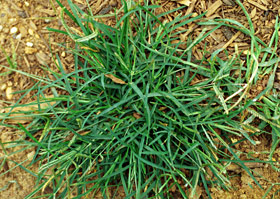Goosegrass, Eleusine indica

John D. Byrd, Mississippi State University, Bugwood.org.
IPM Steps to Reduce Goosegrass
1. Sample for Pest
Confirm the presence of goosegrass before you treat.
Where to find it while inspecting: Goosegrass tolerates compacted soil and will take over in places where your turfgrass is struggling.
2. Proper ID
Is it goosegrass?
Size and Appearance: Dark green, coarse grass, usually flat. Most notable: lower leaf stems are white near the base
3. Learn the Pest Biology
What is the life cycle of goosegrass?
Life Cycle: Produces seeds on seedhead stems between July and September. The seedhead spikes are flat, usually horizontal and resemble a windmill. Close up, the seeds are attached to the stem in a manner resembling a zipper.
Preferred Habitat: Goosegrass does well in dry, compacted soil
4. Determine Threshold
How much is too much goosegrass?
Threshold: Because goosegrass and its seedheads are low and often escape mowing, you will want to remove them before they get too well established.
5. Choose Tactics
Creating a healthy soil condition and understanding turfgrass’s needs is the first step in reducing turf pests. Best management practices for goosegrass include:
Best Management Practices: Maintain proper soil pH: 6.0 to 6.8 (test every 3–5 years). Fertilize at the proper time for turfgrass root development, primarily fall (late spring at times when turf is weak and thin), irrigate if needed, mow at proper height (removing no more than 1/2 of the blade), amend poor soil, choose proper turfgrass seed for your conditions, buy quality seed, overseed thin spots in fall or early spring, remove thatch. Reduce compaction where possible and your desired turfgrass will have a better chance of survival.
Treatment Methods: To control goosegrass without chemicals, mechanically remove or hand pull. Maintain turf density and health through proper culture, especially during spring and summer. Increase drainage and avoid light frequent irrigation, summer fertilization, and close mowing or scalping. Reduce soil compaction by limiting traffic, especially when the soils are wet; core aerify when the turf is actively growing. Herbicide treatments are not always effective—primarily pre or post emergence herbicides done in spot treatments.
6. Evaluate
Was the tactic successful? Record the date pests were first noted, and the tactic you used, and its success. Use one of our RECORD KEEPING tools.
Remember:
When a pesticide application is necessary, all necessary and required precautions are taken to minimize risk to people and the environment and to minimize risk of pesticide resistance or pest resurgence. Pesticide use in your school may be prohibited or regulated by local policies or state and federal regulations. Risk reduction methods can include, but are not limited to, spot-treatment, the use of gel or paste bait formulations placed in inaccessible locations, injection into a crack or crevice, and other methods that reduce potential exposure.